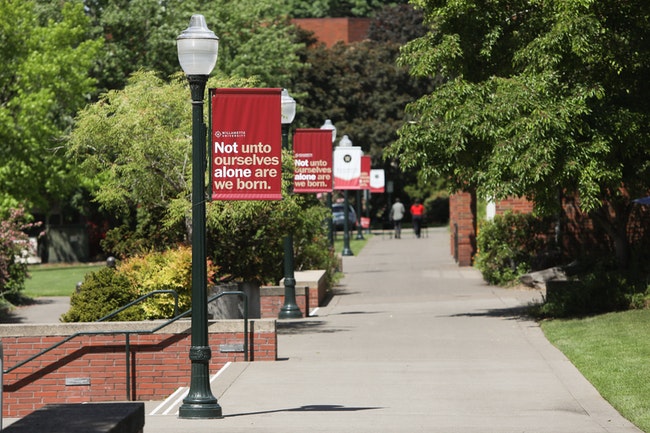
Two people walk through Willamette University on May 15. 2020. (Amanda Loman/Salem Reporter)
Willamette University is slashing its “sticker price” tuition rate by almost $10,000 per year in a bid to attract more students to Oregon’s oldest university, which has seen falling enrollment for several years.
Starting next fall, the cost of a year of tuition for a full-time undergraduate student will be $43,500, down from $53,300 – an 18% cut. The university’s three graduate schools are not affected.
It’s a change that will have little impact on either university finances or the amount most students actually pay to attend the school. Only a handful of students on campus pay anything close to the published rate.
University leaders said the goal is to make Willamette seem more accessible to students and families applying to college who may not realize the average student pays less than half of the published price.
“How many families aren’t even getting to the point of applying because they’re seeing that high sticker price?” said Mary Randers, Willamette’s dean of admission.
Randers said the university’s data showed high cost was one reason students were dropping out of Willamette’s application process or not adding the university to their list of possible schools in the first place.
Prior to the cut, a typical Willamette student had 55% of tuition costs paid for through grants, scholarships and other financial aid, Randers said. Next year, she expects that number will be about 45% because of the reduced tuition.
That number, called a tuition discount rate, has been climbing at colleges and universities around the U.S. in recent years, according to reports from the National Association of College and University Business Officers.
That’s often an attempt to bolster enrollment numbers, but the association’s data suggested results are mixed. About half of the private non-profit schools they looked at saw enrollment fall further after discounting tuition, while others saw gains.
Willamette’s enrollment has fallen significantly in recent years, with a peak of 2,384 undergraduate students enrolled in the fall of 2015, versus just 1,624 last fall. This fall, it’s fallen farther to 1,303 undergraduates.
National trends explain much of the decrease. The number of 18 to 24-year-olds in the U.S. has stopped growing, and the cost of attending college has grown far faster than family income.
Willamette also saw an enrollment hit when the University of California systems began admitting more in-state students in 2015, Willamette’s President Steve Thorsett told OPB last fall. Willamette had in previous years drawn about half its undergraduates from California.
Many colleges have cut tuition or halted planned increases in response to the Covid pandemic, recognizing students attending classes remotely aren’t getting the full benefit of an on-campus experience. Willamette students this year had an option to attend classes in-person or remotely.
Nationally, CNBC reported private four-year colleges like Willamette increased their price 2.1% on average for next fall – the lowest such increase in three decades.
Some schools have taken the same step as Willamette, including Hendrix College, a small liberal arts school in Conway, Arkansas, which announced a 32% cut in the published tuition price for incoming students next fall.
Laura Taylor, associate provost of finance, said Willamette leaders began discussing cutting tuition last fall before the pandemic accelerated a national discussion about college affordability.
She said many at Willamette were increasingly uncomfortable with the growing gap between the published tuition price and what most students actually pay.
They arrived at the $43,500 figure by considering tuition rates for the four other liberal arts schools in the Pacific Northwest that typically serve as a point of comparison, including – Reed College, Lewis and Clark College, Whitman College and University of Puget Sound.
Randers said the pandemic made it more apparent that cutting tuition was the right move.
“We were all going in knowing that it would be almost tone-deaf for the reality of many American families to say we were going to raise tuition,” she said. “If we weren’t going to raise tuition, why not do more? Why not lead the conversation?”
The cut will make the cost of attending Willamette cheaper in coming years, because future tuition increases will start from a lower base price. Taylor said that’s especially helpful to returning students who often don’t see their financial aid awards increase proportionally to rising tuition.
“Students continually have to fund that gap, that increase out of pocket,” she said.
The university’s Board of Trustees approved the lowered rate in October.
Taylor said the cost to the university isn’t yet clear because Willamette is currently budgeting for next year, but she expects it will be small enough that the university won’t need to cut programs or positions to offset the cost.
The full impact will depend on whether the reduced price helps bolster Willamette’s enrollment, something university leaders won’t have a good picture of until the spring.
This article was updated on Nov. 11 at 2 p.m. to add Willamette’s 2020 enrollment numbers.
Contact reporter Rachel Alexander: [email protected] or 503-575-1241.
SUPPORT ESSENTIAL REPORTING FOR SALEM – A subscription starts at $5 a month for around-the-clock access to stories and email alerts sent directly to you. Your support matters. Go HERE.

Rachel Alexander is Salem Reporter’s managing editor. She joined Salem Reporter when it was founded in 2018 and covers city news, education, nonprofits and a little bit of everything else. She’s been a journalist in Oregon and Washington for a decade. Outside of work, she’s a skater and board member with Salem’s Cherry City Roller Derby and can often be found with her nose buried in a book.









